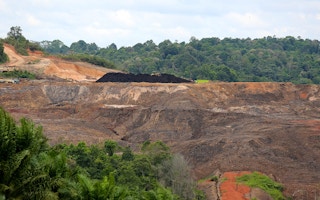Indonesia provides a litmus test for the World Bank’s commitment to divest from coal, with a recent report revealing its continued indirect financing of some of Indonesia’s most destructive coal-mining companies.
The report by Inclusive Development International, Bank Information Center Europe and Jakarta-based coal watchdog JATAM, shows that the World Bank’s private-sector arm, the International Finance Corporation (IFC), financed commercial banks and private equity funds that then invested in six coal companies in Indonesia.
Collectively, these companies dug up 227 million tons of coal in 2017; if all of it were fed into power plants, it would generate 458 million tons of carbon dioxide emissions — higher than Brazil’s emissions, and equivalent to 12th place on the list of top emitting countries.
The report was released during a policy forum in advance of the World Bank’s 2019 Spring Meetings in Washington, D.C. The multilateral lender pledged in 2013 to end direct financing for coal.
Green equity strategy
“The IFC is taking welcome steps to address the harms in its financial-sector portfolio, including pledging to reduce coal exposure to zero and help its clients step away from coal,” said Kate Geary, co-director of Bank Information Center Europe. “But the devil is in the details, and we will be watching closely for any loopholes which allow this dirty financing to continue.”
In 2016, the IFC’s chief executive, Philippe Le Houérou, acknowledged that the institution had a coal problem and that it “must do better” with its financial intermediary business. In 2018, IFC officials began to discuss plans that would give shape to Le Houérou’s call to action. The draft of the plan was recently unveiled, called the Green Equity Strategy.
Under the strategy, client banks must commit to not finance coal projects and shift their financing toward green energy instead. The phase-out will be gradual, with clearly defined targets that become stricter over time, with the ultimate goal of a total phase-out of coal financing by 2030.
The IFC says it will also increasingly require its clients to direct its money toward specific development purposes, such as loans for small businesses and renewable energy, which would effectively exclude coal. Geary said this “ring fencing” approach signaled “the beginning of the end for coal.”
Loopholes detected
With IFC funds being directed to coal companies in Indonesia, the new report says the Southeast Asian country offers an opportunity for the financial institution to implement its Green Equity Strategy and review all of its investments in the country.
The strategy could have a substantial positive impact, the report says, but only if it fully addresses the loopholes detected in the report. For instance, the strategy gives only a loose definition of what constitutes “coal exposure.”
“Without a clear definition that goes beyond project finance to account for the many ways in which banks fund coal, IFC clients could in theory meet the green equity targets while still funneling substantial capital to coal,” the report says.
Another weak point is the 2030 deadline for the total coal finance phase-out, which the report says is too lenient in light of the urgent need to clamp down on carbon emissions and stave off catastrophic climate change effects.
The report calls on the IFC to bring the deadline forward to 2022 and tighten lending restrictions by only investing in new banks and funds with a maximum 15 percent of coal exposure — and then only if they agree to implement a decarbonisation plan leading to zero coal exposure by 2025.
“The effectiveness of the green equity strategy ultimately depends on the IFC’s ability to hold banks to such commitments,” the report says. “The IFC must be clear eyed and principled about this strategy, which means being prepared to divest its stake in banks that don’t make a firm commitment to meet the targets or do not follow through on those commitments.”
Not just smoke and mirrors
The report also raises doubts about the effectiveness of the ring-fencing method, employed by the IFC for years, saying the institution “has such a troubled track record with the practice.”
According to a review of 38 IFC loans targeting small and medium-sized enterprises, the organisation’s independent watchdog, the Compliance Advisor Ombudsman, found that the vast majority were ineffective as these deals lacked legal enforceability and traceability.
The report says the ombudsman’s findings indicate serious flaws with how the IFC ring-fences its investments. In the specific case of a Vietnamese lender, VP Bank, a financial intermediary of the IFC, the lender actually decreased the relative size of its small-business portfolio after receiving a loan from the IFC intended to increase lending to small and medium-sized enterprises.
The report calls on the IFC to be more transparent, rigorous and accountable in its ring-fencing of financial-sector investments.
It also lays out steps the IFC can take to achieve that goal, such as disbursing its money into designated accounts exclusively reserved for targeted sectors; including ring-fencing terms in loan agreements to make them legally enforceable; publicly disclosing the use of such funds; and having them audited by a third party on a yearly basis.
“Money is fungible so if the IFC doesn’t put strict measures in place to ensure that its funds are actually being used to achieve a positive development impact, then banks will continue to go about their business as usual while reaping the benefits of the World Bank’s green stamp of approval,” said David Pred, executive director of Inclusive Development International.
He added, “The taxpayers who fund the World Bank need to be given much more assurance that this isn’t just a bunch of smoke and mirrors.”
This story was published with permission from Mongabay.com.










